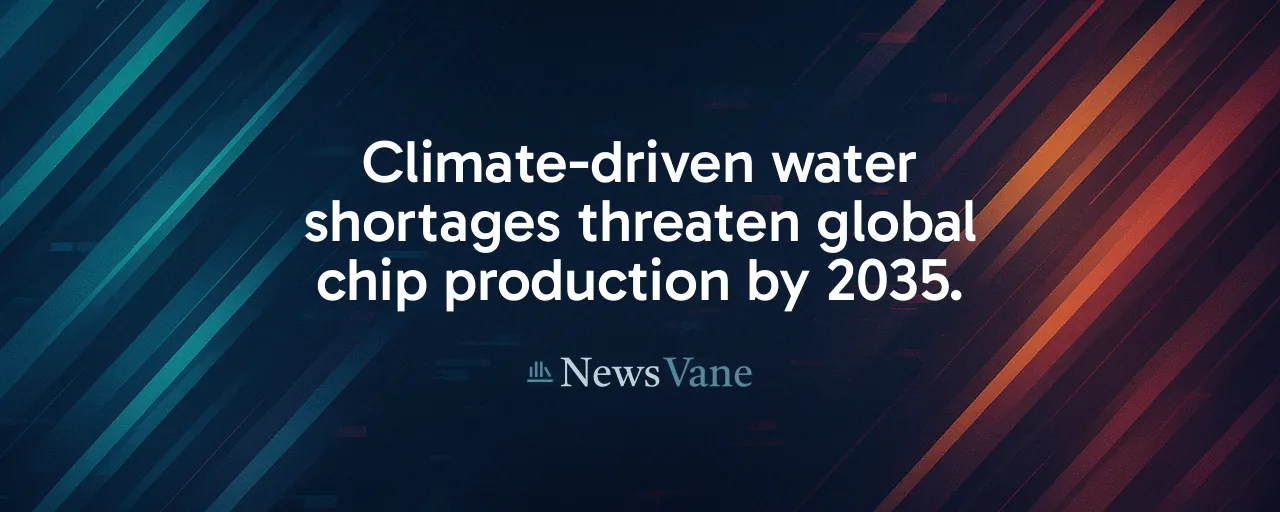A Chip Industry on Edge
A new report from PricewaterhouseCoopers, highlighted by Reuters, sounds an alarm for the semiconductor industry. By 2035, climate-driven water scarcity could disrupt a third of global copper production, a critical material for chip wiring. As the tech sector races toward a $1-trillion valuation, this looming shortage threatens to ripple across electronics, automotive, and renewable energy markets.
Copper is the backbone of modern chips, enabling the microscopic connections that power everything from smartphones to electric vehicles. Mining and refining this metal, however, demand vast amounts of water, a resource growing scarcer in key production regions like Chile and Peru. With drought risks intensifying, the industry faces a supply chain vulnerability that could dwarf the disruptions of the 2020-22 chip shortage.
The challenge involves ensuring a steady flow of chips while balancing economic growth with environmental limits.
Water, Copper, and a Parched Planet
Semiconductors account for about 15 percent of the world's ultra-pure copper demand. Chile, the top supplier, produces 27 percent of global mined copper, but its mining regions face severe drought at least four months a year by the 2030s, according to water-stress models. Modern open-pit mines guzzle over 3,000 cubic meters of water per tonne of refined copper, making them acutely sensitive to climate shifts.
Historical data offers context. Copper replaced aluminum in chips in the late 1990s for superior conductivity, but price spikes in 2006 and 2011 squeezed chipmakers' margins without causing widespread production halts. Today's challenge is different. The PwC report projects a 20 million-tonne copper deficit by 2035, driven by soaring demand for green technologies and worsening water scarcity.
The economic fallout could be staggering. The 2020-22 chip shortage cut an estimated 1 percentage point off U.S. GDP. PwC warns that copper-driven disruptions could cost the global tech sector $250 billion annually, hiking prices for consumer electronics and slowing the shift to electric vehicles and renewable energy.
Practical Fixes in a Complex Web
Solutions exist, but they require coordination across industries and borders. One immediate step is boosting copper recycling. Studies suggest recycled copper could meet up to 35 percent of demand by 2030. Global e-waste collection rates, however, languish below 20 percent in many economies, hampered by logistical bottlenecks. Scaling national recycling programs, with manufacturer take-back mandates and tax incentives, could close this gap.
Another option is water-efficient mining. Desalination plants, which turn seawater into usable water, are gaining traction in Chile and Peru. These facilities, however, require billions in upfront investment and add 6-9 cents per pound to copper costs. Closed-loop water systems, which reuse water on-site, offer a cheaper alternative but need stricter regulatory enforcement to ensure compliance.
Longer-term, research into alternative chip materials like cobalt or ruthenium shows promise. These metals resist electromigration better than copper at sub-2 nanometer scales, but their higher resistivity and production challenges mean mass adoption is a decade away. For now, diversifying copper sources and investing in climate-resilient infrastructure remain the most viable paths.
Balancing Growth and Responsibility
The issue demands a delicate balance. Expanding domestic mining, as some advocate, could enhance supply security. In the U.S., untapped reserves in Arizona and Montana await development, but lengthy permitting processes under environmental laws slow progress. Speeding approvals while enforcing water-conservation standards could bridge economic and ecological priorities.
Communities near mines, meanwhile, face real trade-offs. Water diversion for mining often pits industrial needs against local agriculture, sparking tensions. In Chile, drought since 2010 has already reduced mine yields, foreshadowing broader conflicts. Public-private partnerships to fund desalination and pipeline infrastructure could ease these strains, but they require political will and clear accountability.
Global cooperation is equally critical. Trade agreements linking copper access to environmental and labor standards could stabilize supply chains while promoting sustainability. Such pacts, however, involve navigating complex geopolitics, as nations like the U.S., EU, and China vie for tech dominance.
A Future Worth Building
The copper crunch is a wake-up call for the tech industry and beyond. It underscores the need to align innovation with environmental realities. Recycling, water-efficient mining, and diversified sourcing offer practical steps to avert a crisis that could cost billions and stall progress on clean energy.
Collaboration among semiconductor giants, copper miners, governments, and local communities is essential to ensure supply chains remain robust without exhausting natural resources. Investments in desalination, recycling programs, and material research can pave the way for a resilient tech ecosystem.
Avoiding a future of shortages and missed opportunities is paramount.
